|
Sightseeing tour «Kyiv wonders»
Sightseeing tour «Kyiv wonders»
Kyiv is one of the oldest cities in the Eastern Europe. Its history has more than 15 centuries! Undoubtedly, the historical epochs left a mark on the modern city. And nowadays the creations of the previous centuries look as the marvelous wonders… During the sightseeing tour «Kyiv wonders» you will get acquainted with:
- Ancient Kyiv – Kyiv as the capital of might powerful state – Kyivan Rus. You will see famous Golden gate – the ceremonial entrance to old city, Saint Sophia Cathedral – the oldest church in Kyiv with an inimitable collection of ancient frescos and mosaics inscribed into the UNESCO World Heritage List. You will feel the true atmosphere of the city at the Kyiv’s Acropolis – place where the Kyiv was founded.
- Imperial Kyiv – Kyiv as a part of Russian Empire. You will be delighted by luxury and beautifully decorated buildings in baroque, renaissance classicism, art nouveau style… Thus, St. Andrew church is a baroque pearl of Ukraine, towering atop of the Kyiv hill… When you visit Volodymyr’s cathedral you will feel yourself like in the fairytale temple or like in the art gallery because it was painted by outstanding artists for that period of the time.
- Soviet Kyiv – Kyiv as the capital of Ukrainian Soviet Socialistic Republic. You will have an opportunity to see a unique architectural ensemble of Khreshchatyk street – the main street in Kyiv. Being completely destroyed during the World War II it was rebuilt in so called Stalinist Empire style in 1950-is. We will pass the Government quarter and you will see building of the highest body of state executive power in Ukraine – the Cabinet of Ministers of Ukraine and the building of Ukraine’s parliament – Supreme Council. What is more, during the tour you will be able to see the highest statue in Ukraine – huge Monument to Motherland – the symbol of the power and majesty.
- Modern Kyiv – Kyiv as the capital of Ukraine – an important industrial, scientific, educational, and cultural centre of Eastern Europe. You will feel yourself in the European city looking at the high skyscrapers, modern road junctions and busy citizens.
During the tour we will have several stops in the most picturesque places of Ukrainian capital and you can take unforgettable pictures! After the review of Kyiv landmarks you will unravel the main mystery of Kyiv – you will find out the true «face» of the city!
 Golden Gate Golden Gate
Golden Gate is the branch of National reserve “St. Sophia of Kyiv”.
Today, the building consists of two parts of different periods – the pieces of walls of gate of XI century and protective pavilion which is the recreation of primitive appearance of building. After the restoration in May, 1982 a museum was open here, where it is possible to become acquainted not only with the history of building of the Golden Gate, its research, construction of protective pavilion, but also to know about ancient Kyiv. The museum is open for visitors in a spring-summer season.
|
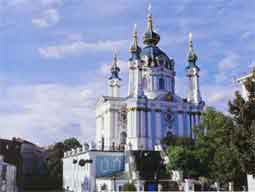 St. Andrew's Church St. Andrew's Church
Is pearl of temple architecture of baroque style.
It was erected in 1753 (architect B. Rastrelli, I. Michurin). The dome was decorated with lucarnes, the gilt cartouches on the facades of the church contain the monogram of Queen Elizabeth. A height of the church is 60 m (without a stylobate – 46 m), sizes of building 32x23 m. According to the report of architect I. Michurina there were used 23,500 bricks, 28,970 nails for the construction of St. Andrew's church; considerably later, at additional works, on the gilt of tops were used 1590 books of 20 folias of sheet gold.
|
.jpg) National reserve St. Sophia of Kyiv National reserve St. Sophia of Kyiv
Was the main square of Kyiv is times of Prince Yaroslav Mydryi (Wise)
According to the chronicle "The Tale of Bygone Years", here, on "the field outside the city," In 1036 Yaroslav defeated nomads Pechenegs, who were making their invasion for more than a hundred years; the next year after victory Yaroslav has begun the construction of grand temple on the place of victory. Other ancient sources refer to the foundation of St. Sophia to 1017. Construction was carried out for years, until the cathedral appeared in all its beauty.
The construction of St. Sophia was for Yaroslav the act of establishing the state might of Kievan Rus. Metropolic church was named as the main sanctuary of Constantinople – Hagia Sophia – because of desire not to yield to Byzantium.
|
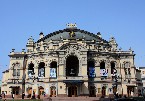 National Opera of Ukraine National Opera of Ukraine
Opposite the new building on front of Volodymyrska street there is a monumental building in style of neo-renaissance - the National Academic Theatre of Opera and Ballet of Ukraine Named after Ò. Shevchenko.
It was erected in 1898 - 1901 as the City theatre, in place of an older theatre, that had burned in 1986. Architect V. Shroter, author of project, won in a representative international competition. Architect V. Nikolayiev managed the building. On the facade were set the sculptures of muses of Melpomene and Terpsichor (sculptor Å. Sala). Finishing of interiors is as good as the beauty of external equipment. In 1980 there was held the restoration with the superstructure of stage box (Architect B. Zhezherin, Î. Hrauzhis and other). After this, the bust of Ò. Shevchenko (sculptor Î. Kovalov) was set in the central loggia of facade.
|
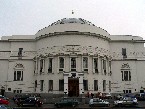 House of Teacher House of Teacher
The House of Teacher was erected in 1910-11 as the Pedagogical museum (inauguration – in 1912).
There was the exposition from the different areas of knowledge, were held the scientific and artistic exhibitions; Kyiv society of guard of sights of antiquity and art worked there. But this house entered to the history of Ukraine first of all because in 1917-18 Ukrainian Central Council worked here. This representative organ, at first formed as a defender of idea of national and territorial autonomy of Ukraine, in November 1917 was acknowledged by the higher authority and grew into parliament of the independent state.
|
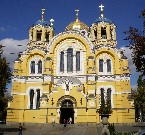 St. Volodymyr‘s Cathedral St. Volodymyr‘s Cathedral
A noticeable place in building of boulevard of Ò. Shevchenko belongs to St. Volodymyr‘s Cathedral.
The collection of donations for the building began in 1852, meantime architect I. Shtorm prepared the project of monumental building in Byzantium style with 13 domes. But because of lack of funds customers shortened the number domes to seven. The final project was made by academician 0. Beretti. In 1862, on the holiday of Volodymyr, the building of cathedral started. During some time the building was going successfully, but suddenly in 1864-66 some archs did not survive the weight of overhead tier and moved aside. Beretti was removed from construction. Works stopped. Only in 1875 under the order of tsar Aleksander II there were found the additional funds and R. Benhard, professor-builder, arrived in Kyiv. According to his calculations V. Nikolayiev completed the building.
|
 Circus Circus
Circus is very popular among the inhabitants of Kyiv, its hall contains 2000 of feats.
At him the circus was created the museum of circus art. Before 1930 in that place was an unusual building – so-called Ferrous church, or temple of John Chrysostom (engineer R. Nikkels, architect Ì. Yurhens, 1867-71). It was really faced with cast-iron foliar with the stamped decorations in "Neo-Russian" style. A market was situated at the three-cornered ground, where today is situated the buildings of circus, decorated by a dome with a spire (architect V. Zhukov, 1960).
|
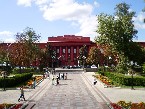 Ò. Shevchenko National University of KyivÒ. Ò. Shevchenko National University of KyivÒ.
Ò. Shevchenko National University of Kyiv was opened in 1834 under the name the "Emperor's university of St. Volodymyr".
At first it was situated in the hired premises. At the same time in Saint Petersburg, the capital of empire was held the competition of projects of university building among the best architects. V. Beretti, professor of architecture, won the competition In 1837 the building started, and in 1842 the lectures were held in the uncompleted premises. V.Beretti died the same year, and his son Aleksander completed all works in 1843.
|
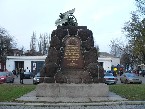 Monument to the Workers of Plant Arsenal Monument to the Workers of Plant Arsenal
Workers of plant "Arsenal" traditionally were the initiators of social disturbances and revolutionary performances.
They became shock force of rebelling against tsarism and Ukrainian national forces, in particular, performances against Central Council in January, 1918. On the wall remained tracks of bullets and shells - as mention about those events. In the centre of the Arsenalna square in front of the metro station "Arsenalna" there is a Monument to the Workers of plant "Arsenal" (1923) - a cannon. The workers used such cannon in a fight with a national army. A pedestal of red granite remained from a former monument to I. Iskra and V. Kochubei (sculptor captain P. Samonov, 1914).
|
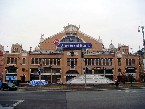 Bessarabskyi Market Bessarabskyi Market
Khreshchatyk, main street of the capital, ends with another visit card of the city – Bessarabska square.
It was a market square as, peasants from Bessarabia (Moldova) brought the commodity here. In 1908-12 the house of Bessarabskyi covered market was built here in style of modern (author of project – Polish architect. H. Hai, building was built by the inhabitant of Kyiv Ì. Bobrusov). Market facades are decorated by original reliefs on the themes of rural labour (sculptors: Î. Teremets, Ò. Rudenko), in the interior there are open metallic constructions. The market was built on money, bequeathed by Lazarus Brodskyi, famous owner of sugar plants. The market is successfully exploited to this day.
|
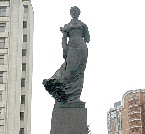 Monument to Lesia Ukraink Monument to Lesia UkrainkIn 1973 on Lesia Ukrainka square in Kyiv was opened the monument to Lesia Ukrainka (sculptor H. Kalchenko, 1973). Lesia Ukrainka (the real name is Larysa Petrivna Kosach-Kvitka) was the prominent Ukrainian poetess, dramatist and prose writer, daughter of the Ukrainian authoress Olena Pchilka. She was born on February 25, 1871 in Novohrad-Volynskyi, Zhytomyr region in nobiliary family.
|
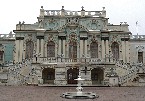 Mariinskyi Palace Mariinskyi Palace
In 1744, being in Kyiv, an empress Elizabeth defined the place for construction of palace for tsar's visits – the Mariinskyi (Maria’s) palace.
Architect I. Michurin erected the palace in style of baroque, based on the buildings of V. Rastrelli, who was favourite architect of empress. The construction of two-storey building with service wings lasted up to 1752.
|
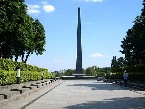 Monument of Eternal Glory Monument of Eternal Glory
The Square of Glory (Ploshcha Slavy) is formed by the green array of park of Eternal Glory, located on the top terrace of Dnieper bank.
In 1957 this place was transformed on a memorial in honour the winners of fascism. V. Chuikov, Marshal of Soviet Union, solemnly set fire the Eternal here. Monument of Eternal Glory was set the on the grave of Unknown soldier – it is a slender obelisk of 27 m high (architects I. Miletskyi, V. Baklanov, L. Novikov). A wide alley leads to this monument, on either side of it there are 34 graves of soviet warriors, which participated in a defense and liberation of Kyiv.
|
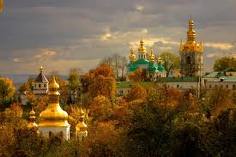 Kyiv-Pechersk Lavra Kyiv-Pechersk Lavra
Kyiv-Pechersk Lavra was the decoration and glory of Pechersk since old times.
This is a prominent sacred object not only for the city but also for the whole orthodox world. A word "Pechersk", as well as name, Pechersk, originates from the caves (pechery in Ukrainian) on Dnieper banks, where the monasteries operated since 1051. St. Anthony, monk from Liubech, put the beginning to the Pechersk monastery. "Lavra" is the Greek word which means "plenty", but literally it means a street, a built-up town quarter. The Pechersk monastery was named a lavra since XII of century; official status of Lavra was confirmed in 1688.
|
.jpg) Monument to Mother-Motherland Monument to Mother-Motherland
Memorial complex of the National Museum of History of the Great Patriotic War 1941 - 45 occupies an area of 10 hectare on a hill above Dnipro.
It was built in 1981 by the group of authors (sculptors V. Borodai, F. Sohoian, architec V. Yelizarov and other) under the plan of sculptor Ye. Vuchetych. The dominant link of memorial is building of museum, on which, as on a pedestal, was set the statue of Mother-Motherland of 62 m high. The General height of building is 108 m. Weight of the monument – 530 tons. A statue holds a 16-meters sword in the right hand, and a shield with the coat of arms of the USSR in the left one.
|
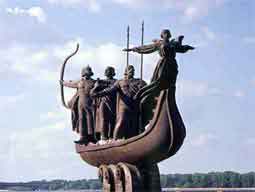 Monument to the Founders of City of Kyiv Monument to the Founders of City of Kyiv
Ashore Dnipro there is a Navodnytskyi park.
In a park a memorable sign is set – the Monument to the Founders of City of Kyiv – Brothers Kyi, Shchek, Khoryv and Sister Lybid (skulptor V. Borodai, architect Ì. Feshchenko, 1982). Here, usually, some young inhabitants of Kyiv lay their flowers as a part of wedding ceremony.
|
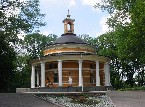 Askold’s Grave Askold’s Grave
A bit below from Slavy square there is the Parkova road. Here among the picturesque greenery the protected locality – Askold’s grave – is located.
In 1810 in place of previous wooden temple of St. Nicholas appeared a new church of stone in the form of rotunda covered by a dome (architect I. Melenskyi). Varyags guard killed Askold and Dir, and Oleh became the Prince of Kyiv. Askold was baptised under the name of Mykola and tried to enter Christianity. Varyags guard killed Askold and Dir, and Oleh became the Prince of Kyiv, declaring: "This will be the mother to the Russian cities".
|
|
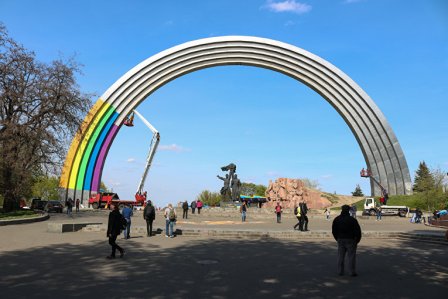 Monument in Honour of Reunion of Ukraine with Russia Monument in Honour of Reunion of Ukraine with Russia
The open stage left from the old Merchants garden. But in 1982 instead of it there was erected a pompous Monument in Honour of "Reunion of Ukraine with Russia". It consists of enormous "Arch of friendship" which has a look of metallic rainbow of 30-meter radius, and also sculptural compositions - bronze figures of the Ukrainian and Russian workers, which carry the soviet order of Friendship of people together, and granite image of participants of the Pereiaslav Council, in 1654.
|
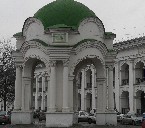 Samson Fountain Samson FountainSimultaneously with the reconstruction of trade rows, the revival of interesting sight of antiquity took place: near the north line of the Hostynnyi Dvir "Samson" fountain was recreated. In 1749 a fountain appeared here under the arched brick pavilion, decorated by double columns of the Corinthian warrant (architect I. Hryhorovych-Barskyi). It was a functional part of Podilsk water supply - original regulator of water level. At first the fountain was executed as a figure of Angel, and it was named "Felicial" or "Felician". But in 1809 the figure of Samson, tearing lion's mouth, appeared here. It was done on the celebration of 100 years of Poltava battle.
|
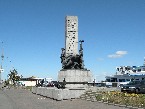 Monument to the Sailors of the Dnipro Flotilla Monument to the Sailors of the Dnipro Flotilla
There was a military flotilla on Dnipro, which had been officially created in 1696. The River military ships participated in the events of civil war; the river sailors protected the city from a fascist invasion in 1941 with an exceptional courage.
In 1979 a monument was set near the River Station – it represents the bronze figures of sailors and names of famous ships of the Dnipro military flotilla (sculptors Ì. Vronskyi, 0. Skoblykov). A monument stands on well-organized embankment, made of granite. A stair goes down from the cast-iron fence of monument to water.
|
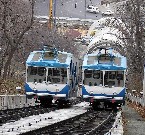 Funicular Funicular
In 1905 the "Mykhailivkyi ascent” – Funicular was built. This is a comfortable transport vehicle with two suspended carriages (engineers I. Abrahamson, Î. Barysnikov, Ì. Piatnytskyi).
The upper station was saved in the partly reconstructed kind, in it’s hall a historical diorama was set in 1995 .
|
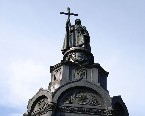 Monument to the Prince Volodymyr Monument to the Prince Volodymyr
On the middle terrace of park "Volodymyrska Hill", there is situated a Monument to the Prince Volodymyr - Baptizer of Rus, since 1853.
It is the first sculptural monument in Kyiv. The project was made by the Petersburg sculptor V. Demut-Malynovskyi, carried out by baron P. Klodt; 0. Ton, professor, was the architect of monument. The majestic statue of saint prince with a cross in his right hand and princely cap in the left one was set on a brick pedestal with cast-iron facing. On a pedestal there are a bas-relief image of christening of inhabitants of Kyiv, regalia of order of saint Volodymyr (stars and crosses), symbols of christening a "fire and sword" and coat of arms of Kyiv - Archangel Michael. The height of monument is 20,5 m.
|
 P. Chaikovskyi National Musical Academy of Ukraine P. Chaikovskyi National Musical Academy of Ukraine
4-storeyed building of opera studio of the National Musical Academy of Ukraine Name after P. Chaikovskyi (former Conservatory) is a part of Maidan Nezalezhnosti.
This building with a concerto hall (architect L. Katok, 1955-59) is equipped in a classic spirit, at the level of 3-4 floors it is decorated by a colonnade with ionic caps. The complex of the National Musical Academy includes also a contiguous educational corps for the on 5 Architect Horodetskyi street.
|
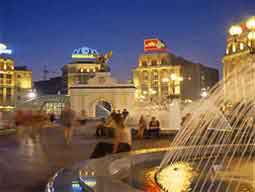 Maidan Nezalezhnosti Maidan Nezalezhnosti Right after the proclamation of independence of Ukraine the square of October Revolution got the new proud name - the square of independence (Maidan Nezalezhnosti).
In front of the house of general post-office, near the sculpture to the globe, there is indicated information about distances from Kyiv to the centres of Regions of Ukraine and Crimean autonomy, and also to the capitals of all states - members of the World postal union. Folk festivals, concerts are regularly held on the square.
|
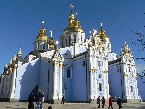 St. Michael’s Golden-domed Cathedral St. Michael’s Golden-domed Cathedral
St. Michael’s Monastery was one of the oldest Kyiv sacred objects. In XI century in this place there was St. Dimitrius Monastery, founded by the Kyiv Prince Iziaslav Yaroslavych (the Christian name is Dmytro).
In July, 1108 his son Sviatopolk (the christian name is Mykhailo) began to erect the Mykhailivskyi St. Michael’s temple in a paternal monastery. The roof of the domes was over-gilded and new cathedral, and afterwards all monastery was named St. Michael’s Golden-Domed. A cathedral was blasted in 1934-1936, in 1998-2000 it was rebuilt again.
|
|
|
|
|
|
|
|
Individual tours in Ukraine
|
|
Ukraine, Kiev, str Yaroslavskaya H39v ap32
+ 380 44 2391756
+ 38 0674093933
e-mail: likushka@ukr.net
booking@imperialtravel.biz
skype: lika_kostina
weChat: LikaKostina
 
|